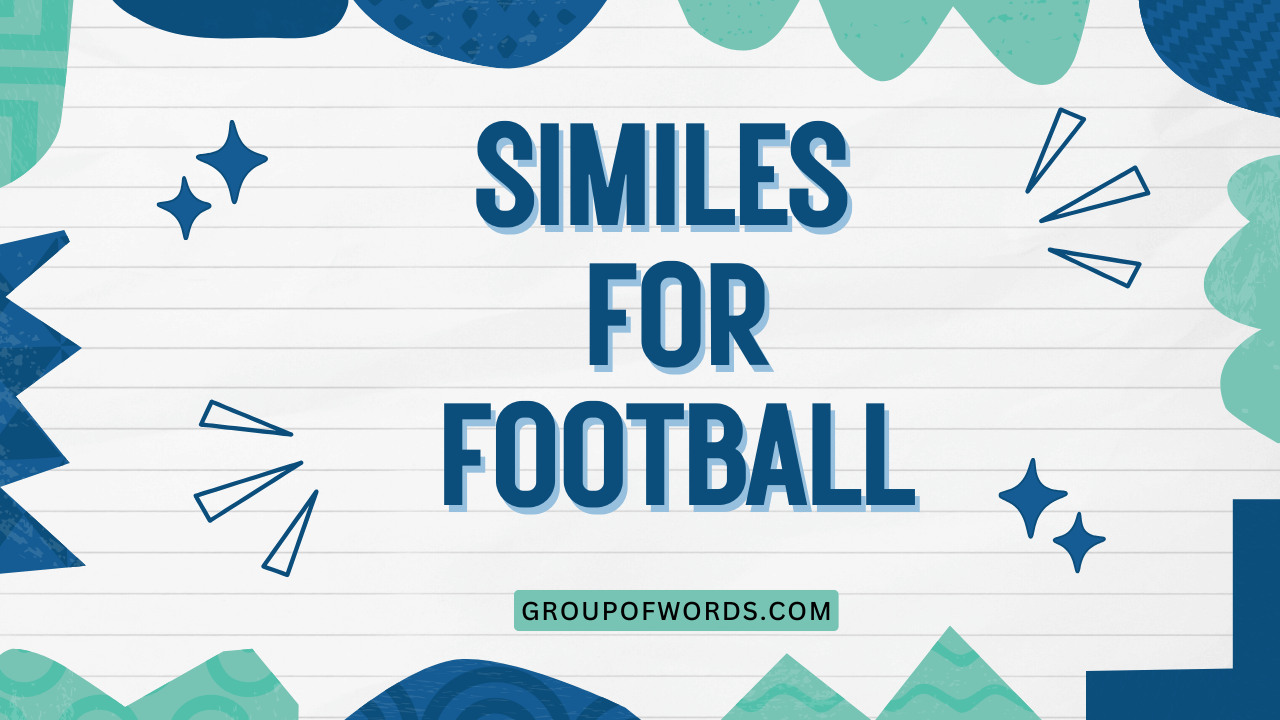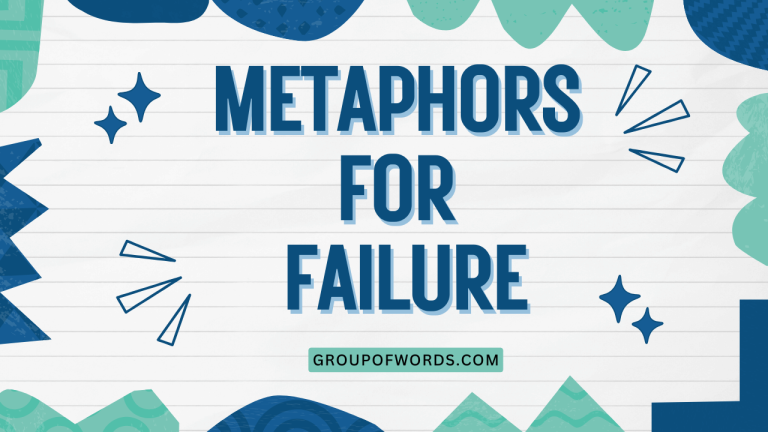Football Similes: A Grammatical Playbook for Vivid Language
Similes are powerful tools for enhancing our writing and speech, allowing us to create vivid comparisons that resonate with our audience. In this article, we’ll explore the exciting world of football similes, examining how these figures of speech can be used to describe the action, the players, and the overall atmosphere of the game.
Whether you’re a seasoned writer, an English language learner, or simply a football enthusiast, this guide will provide you with a comprehensive understanding of similes and their effective application in the context of football.
Understanding similes is crucial for mastering figurative language, a key component of English grammar and rhetoric. By learning to identify and use similes effectively, you can elevate your writing and communication skills, making your descriptions more engaging and memorable.
This article is designed for students, writers, sports enthusiasts, and anyone interested in improving their grasp of English grammar and figurative language.
Table of Contents
- What is a Simile?
- Structural Breakdown of Similes
- Types of Football Similes
- Action Similes
- Player Similes
- Atmosphere Similes
- Examples of Football Similes
- Offensive Similes
- Defensive Similes
- Special Teams Similes
- Coach Similes
- Fan Similes
- Usage Rules for Similes
- Common Mistakes with Similes
- Practice Exercises
- Advanced Topics in Similes
- Frequently Asked Questions
- Conclusion
What is a Simile?
A simile is a figure of speech that compares two unlike things using the words “like” or “as.” It’s a powerful tool for creating vivid imagery and helping your audience understand something in a new or more relatable way. Unlike a metaphor, which directly equates two things, a simile acknowledges that the two things being compared are distinct but share a common quality.
The primary function of a simile is to enhance description and make writing more engaging. By drawing a comparison, similes can evoke emotions, create a sense of familiarity, and make abstract concepts more concrete.
They are commonly used in literature, poetry, everyday conversation, and, of course, sports commentary.
Similes are classified as a type of figurative language, specifically belonging to the category of comparative figures of speech. They rely on the reader or listener’s ability to understand the connection between the two seemingly disparate elements being compared.
This connection is usually based on a shared characteristic or quality.
Structural Breakdown of Similes
The basic structure of a simile is quite straightforward. It consists of two main components: the subject being described and the object to which it is being compared, connected by either “like” or “as.”
The general formula for a simile is: Subject + “like” or “as” + Object. Understanding this structure is key to crafting effective and clear similes.
Let’s break down the components with an example: “The quarterback threw the ball like a rocket.”
- Subject: The quarterback’s throw
- Connecting word: like
- Object: A rocket
The simile compares the speed and trajectory of the quarterback’s throw to that of a rocket, creating a powerful image in the reader’s mind. The effectiveness of a simile lies in choosing objects that resonate with the audience and clearly convey the intended meaning.
Types of Football Similes
Football similes can be categorized based on what aspect of the game they are describing. Here are some common types:
Action Similes
These similes describe the movements, plays, and overall action on the field. They often focus on speed, power, agility, and precision.
Player Similes
These similes compare players to animals, machines, or other figures to highlight their strengths, weaknesses, or playing styles. They might focus on a player’s speed (like a cheetah), strength (like an ox), or agility (like a cat).
Atmosphere Similes
These similes describe the environment surrounding the game, including the crowd, the weather, and the overall feeling of the event. They help to create a sense of immersion and bring the game to life for the audience.
Examples of Football Similes
Here are some examples of football similes, categorized by different aspects of the game. These examples demonstrate how similes can be used to create vivid and engaging descriptions.
Offensive Similes
Offensive similes often describe the speed, power, and precision of the offensive players and their plays. They can also highlight the strategic aspects of the offense.
The table below provides examples of offensive similes used in football.
| Simile | Explanation |
|---|---|
| The quarterback’s pass was as accurate as a guided missile. | Highlights the precision of the pass. |
| The running back moved through the defense like a hot knife through butter. | Emphasizes the ease with which the running back penetrated the defense. |
| The wide receiver caught the ball as gracefully as a ballet dancer. | Highlights the receiver’s agility and coordination. |
| The offensive line blocked like a wall. | Emphasizes the strength and impenetrability of the offensive line. |
| The play unfolded as smoothly as a well-oiled machine. | Highlights the efficiency and precision of the play execution. |
| His throws were as consistent as a metronome. | Focuses on the quarterback’s reliable accuracy. |
| The play action fake was as convincing as a magician’s trick. | Highlights the deception involved in the play. |
| He ran with the ball like a man possessed. | Emphasizes the running back’s determination and intensity. |
| The offense moved down the field as relentless as a rising tide. | Highlights the unstoppable nature of the offensive drive. |
| The receiver was as fast as lightning. | Compares the receiver’s speed to lightning. |
| The quarterback’s arm was like a cannon. | Illustrates the quarterback’s throwing power. |
| The running back dodged defenders like a bumblebee flitting around flowers. | Highlights the running back’s agility and elusiveness. |
| The offensive line protected their quarterback like a fortress. | Emphasizes the offensive line’s protective role. |
| The tight end caught the ball as securely as a bear hugging a honey pot. | Highlights the tight end’s ability to catch the ball. |
| The quarterback’s decisions were as sharp as a razor. | Emphasizes the quarterback’s smart decisions. |
| The offense executed the play as precisely as a surgeon. | Highlights the precision in the play. |
| The team moved down the field like a well-drilled army. | Emphasizes the teamwork and coordination. |
| The quarterback threw the ball as if he had eyes in the back of his head. | Highlights the quarterback’s awareness. |
| The receiver sprinted down the sideline like a greyhound chasing a rabbit. | Compares the receiver’s speed to a greyhound. |
| The team’s offensive strategy was as intricate as a spider’s web. | Highlights the complexity and deceptive nature of the strategy. |
| The running back was as slippery as an eel in the open field. | Emphasizes the running back’s elusiveness and hard-to-tackle nature. |
| The quarterback led the offense as confidently as a seasoned general. | Highlights the quarterback’s leadership and composure. |
| The offensive line surged forward like a tidal wave. | Emphasizes the power and momentum of the offensive line. |
| The receiver caught the ball as if it were glued to his hands. | Highlights the receiver’s secure grip and catching ability. |
Defensive Similes
Defensive similes often describe the strength, aggression, and tenacity of the defensive players and their strategies. They can also highlight the intelligence and adaptability of the defense.
The table below provides examples of defensive similes used in football.
| Simile | Explanation |
|---|---|
| The linebacker hit the running back like a freight train. | Emphasizes the linebacker’s power and impact. |
| The defensive line was as impenetrable as a brick wall. | Highlights the strength and resilience of the defensive line. |
| The cornerback covered the receiver like a shadow. | Emphasizes the cornerback’s tight coverage and agility. |
| The safety roamed the secondary like a hawk. | Highlights the safety’s awareness and coverage range. |
| The defensive strategy was as complex as a chess game. | Highlights the strategic depth and intelligence of the defense. |
| The defense swarmed the quarterback like bees to honey. | Emphasizes the speed and intensity of the defensive pressure. |
| He tackled with the force of a wrecking ball. | Highlights the tackler’s power. |
| The defensive end rushed the passer like a man chasing his wallet. | Emphasizes the defensive end’s determination to pursue the quarterback. |
| The defense was as suffocating as a hot, humid day. | Highlights the oppressive nature of the defensive pressure. |
| The linebacker was as solid as a rock in run support. | Emphasizes the linebacker’s reliability. |
| The defensive back intercepted the pass like a seasoned thief. | Highlights the defensive back’s skill and experience. |
| The safety hit the receiver as hard as a ton of bricks. | Emphasizes the safety’s power and impact. |
| The defensive line was as relentless as a pack of wolves. | Highlights the defensive line’s aggression and persistence. |
| The linebacker diagnosed the play as quickly as a computer. | Emphasizes the linebacker’s intelligence and reaction time. |
| The cornerback stuck to the receiver like glue. | Highlights the cornerback’s tight coverage. |
| The defensive player’s hit was like an earthquake. | Compares the hit to a very strong earthquake. |
| The defensive end was as quick as a viper striking. | Emphasizes the defensive end’s speed and precision. |
| The defense played with the intensity of a raging fire. | Highlights the passion and energy of the defense. |
| The lineman bulled through the offensive line like a bulldozer. | Emphasizes the defensive lineman’s power and force. |
| The defense was as organized as a military unit. | Highlights the strategic planning of the defense. |
| The defender’s grip was like a vise. | Emphasizes the defender’s strong grip. |
| The defensive backs covered the receivers like blankets. | Highlights the defensive backs’ tight coverage. |
| The defense shut down the running game like a dam blocking a river. | Emphasizes the effectiveness of the defense. |
| The defensive players moved as a unit, like a swarm of bees. | Highlights the teamwork of the defense. |
| The linebacker pursued the quarterback like a heat-seeking missile. | Highlights the linebacker’s relentless pursuit. |
Special Teams Similes
Special teams similes describe the kicking, punting, and return aspects of the game. They often focus on the distance, accuracy, and speed involved in these plays.
The table below provides examples of special teams similes used in football.
| Simile | Explanation |
|---|---|
| The kicker’s punt sailed through the air like a shooting star. | Emphasizes the distance and trajectory of the punt. |
| The returner dodged tacklers like a water bug on a pond. | Highlights the returner’s agility and elusiveness. |
| The field goal attempt was as straight as an arrow. | Emphasizes the accuracy of the kick. |
| The kickoff went as high as a skyscraper. | Highlights the height of the kick. |
| The punt returner accelerated like a drag racer. | Emphasizes the returner’s speed. |
| The kick sailed as effortlessly as a paper airplane. | Focuses on the appearance of ease, despite the power needed. |
| The tackle on the kickoff was as sudden as a lightning strike. | Highlights the unexpected force and speed of the tackle. |
| The coverage team swarmed like angry wasps. | Emphasizes the aggressive pursuit by the coverage team. |
| The long snapper’s delivery was as consistent as clockwork. | Highlights the reliability and precision of the snap. |
| The kick went through the uprights as easily as a marble rolling down a ramp. | Emphasizes the ease and certainty of the successful kick. |
| The punt was as high as a church steeple. | Compares the height of the punt to something very high. |
| The returner was as elusive as a ghost. | Emphasizes the returner’s difficulty to catch. |
| The kicker’s leg was like a piston. | Highlights the kicker’s power. |
| The special teams play was as crucial as a game-winning touchdown. | Emphasizes the importance of the special teams. |
| The punt landed as softly as a feather. | Highlights the gentle landing of the punt. |
| The kicker booted the ball as if it were a bomb. | Emphasizes the kicker’s power and force. |
| The returner cut through the defenders like a knife. | Highlights the returner’s agility and speed. |
| The field goal was as good as money. | Emphasizes the certainty of the successful kick. |
| The kicker’s precision was like a marksman’s. | Highlights the kicker’s accuracy. |
| The punt hung in the air like a suspended moment in time. | Emphasizes the suspenseful nature of the punt. |
| The kick-off sailed through the air as straight as a laser beam. | Highlights the precision and trajectory of the kick-off. |
| The returner’s cuts were as sharp as a switchblade. | Emphasizes the returner’s quick and decisive movements. |
| The special teams unit operated as seamlessly as a synchronized dance. | Highlights the coordination and teamwork of the unit. |
| The field goal attempt was as nerve-wracking as waiting for election results. | Emphasizes the tension and uncertainty of the moment. |
| The punt coverage team descended like a flock of birds. | Emphasizes the speed and coordinated movement of the coverage team. |
Coach Similes
Coach similes describe the leadership styles, strategies, and motivational techniques of the coaches. They can also highlight their impact on the team’s performance.
The table below provides examples of coach similes used in football.
| Simile | Explanation |
|---|---|
| The coach was as intense as a drill sergeant. | Emphasizes the coach’s strictness and discipline. |
| The coach’s strategy was as intricate as a puzzle. | Highlights the complexity and thoughtfulness of the strategy. |
| The coach motivated the team like a fiery orator. | Emphasizes the coach’s ability to inspire and energize the team. |
| The coach’s focus was as sharp as a laser beam. | Highlights the coach’s concentration and attention to detail. |
| The coach guided the team like a seasoned captain. | Emphasizes the coach’s leadership and experience. |
| The coach was as calm as a monk during the tense moments. | Focuses on the coach’s composure under pressure. |
| The coach’s pep talk was as energizing as a caffeine shot. | Highlights the immediate impact and boost provided by the coach. |
| The coach’s game plan was as detailed as a blueprint. | Emphasizes the thoroughness and precision of the plan. |
| The coach was as perceptive as a psychologist in understanding his players. | Highlights the coach’s ability to understand and connect with his team. |
| The coach’s authority was as absolute as a king’s. | Emphasizes the coach’s control and influence over the team. |
| The coach’s voice boomed like thunder. | Compares the coach’s loud voice to thunder. |
| The coach’s mind was like a steel trap. | Emphasizes the coach’s sharp memory. |
| The coach’s leadership was as strong as steel. | Highlights the coach’s ability to lead. |
| The coach’s determination was like a burning flame. | Emphasizes the coach’s drive and passion. |
| The coach’s presence was as commanding as a general’s. | Highlights the coach’s authority and respect. |
Fan Similes
Fan similes describe the behavior, passion, and energy of the fans in the stadium. They can also highlight their impact on the game’s atmosphere.
The table below provides examples of fan similes used in football.
| Simile | Explanation |
|---|---|
| The crowd roared like a pack of lions. | Emphasizes the loudness and intensity of the crowd noise. |
| The stadium was as electric as a lightning storm. | Highlights the excitement and energy in the stadium. |
| The fans cheered as wildly as a flock of seagulls. | Emphasizes the enthusiastic and chaotic nature of the cheering. |
| The atmosphere was as tense as a tightrope walker. | Highlights the nervousness and anticipation in the stadium. |
| The fans celebrated the victory like they had won the lottery. | Emphasizes the joy and excitement of the fans. |
| The stadium was as packed as a can of sardines. | Focuses on the density of the crowd. |
| The fans were as dedicated as monks to their team. | Highlights the unwavering loyalty and commitment of the fans. |
| The noise level was as deafening as a jet engine. | Emphasizes the extreme loudness of the stadium noise. |
| The fans painted their faces as elaborately as tribal warriors. | Highlights the dedication and creativity of the fans’ support. |
| The energy in the stadium was as palpable as a physical force. | Emphasizes the intense and tangible excitement in the air. |
| The fans screamed like banshees. | Compares the fans’ screaming to the mythical creatures. |
| The stadium shook like an earthquake. | Highlights the intensity of the crowd’s reaction. |
| The fans were as loud as a rock concert. | Emphasizes the noise and energy of the crowd. |
| The atmosphere was as charged as a battery. | Highlights the intensity. |
| The fans were as passionate as a love-struck teenager. | Emphasizes the fans’ devotion to the team. |
Usage Rules for Similes
While similes are relatively simple to create, there are some rules to keep in mind to ensure they are used effectively:
- Clarity: The comparison should be clear and easy to understand. Avoid obscure or confusing references.
- Relevance: The object being compared should have a clear connection to the subject. The shared quality should be obvious.
- Originality: While some common similes are acceptable, try to create original comparisons that are fresh and engaging.
- Context: The simile should be appropriate for the context in which it is used. Consider the audience and the overall tone of your writing.
- Avoid Clichés: Steer clear of overused similes like “as strong as an ox” or “as fast as lightning.” These can make your writing sound uninspired.
Exception: Sometimes, clichés can be used ironically or humorously, but this should be done intentionally and with care.
Common Mistakes with Similes
Even experienced writers can make mistakes when using similes. Here are some common errors to watch out for:
- Mixing Metaphors and Similes: Avoid combining elements of both in a single comparison.
- Incorrect: “He was a lion, like a king on the field.” (Mixing a metaphor “He was a lion” with a simile “like a king.”)
- Correct: “He was like a lion on the field.” (Simile)
- Correct: “He was a lion on the field.” (Metaphor)
- Using Unclear Comparisons: Ensure the comparison is easy to understand and makes sense.
- Incorrect: “The play was like Tuesday.” (Unclear connection)
- Correct: “The play was as predictable as the sunrise.” (Clear connection)
- Overusing Similes: Too many similes can make your writing feel cluttered and distracting. Use them sparingly and strategically.
Practice Exercises
Test your understanding of similes with these practice exercises. Identify the similes in the sentences below and explain what is being compared.
Exercise 1: Identifying Similes
| Question | Answer |
|---|---|
| 1. The running back was as quick as a hiccup. | The running back’s quickness is compared to a hiccup. |
| 2. The stadium was like a cauldron of noise. | The stadium’s noise level is compared to a cauldron. |
| 3. The quarterback’s pass was as precise as a surgeon’s cut. | The quarterback’s pass is compared to a surgeon’s cut. |
| 4. The defensive line was as immovable as a mountain. | The defensive line is compared to a mountain. |
| 5. The fans cheered like a swarm of bees. | The fans’ cheering is compared to a swarm of bees. |
| 6. The coach’s stare was as cold as ice. | The coach’s stare is compared to ice. |
| 7. The receiver caught the ball as smoothly as silk. | The receiver’s catch is compared to silk. |
| 8. The tackle was as loud as a thunderclap. | The tackle’s sound is compared to a thunderclap. |
| 9. He ran through the defense like a bulldozer. | His run is compared to a bulldozer. |
| 10. The play unfolded as predictably as a clock ticking. | The play’s predictability is compared to a clock ticking. |
Exercise 2: Creating Similes
Complete the following sentences by adding a simile.
| Question | Answer |
|---|---|
| 1. The quarterback threw the ball ______. | The quarterback threw the ball like a dart. |
| 2. The stadium was as quiet as ______. | The stadium was as quiet as a library. |
| 3. The running back dodged defenders ______. | The running back dodged defenders like a fox. |
| 4. The coach’s speech was as inspiring as ______. | The coach’s speech was as inspiring as a battle cry. |
| 5. The fans celebrated ______. | The fans celebrated like they had won the championship. |
| 6. The lineman was as big as ______. | The lineman was as big as a house. |
| 7. The receiver ran as fast as ______. | The receiver ran as fast as the wind. |
| 8. The defense was as tough as ______. | The defense was as tough as nails. |
| 9. The play was executed as perfectly as ______. | The play was executed as perfectly as a symphony. |
| 10. The tension was as thick as ______. | The tension was as thick as fog. |
Advanced Topics in Similes
For advanced learners, exploring the nuances of similes can lead to a deeper appreciation of their power and versatility. Here are some advanced topics to consider:
- Extended Similes: These are similes that are developed over several sentences or even paragraphs, creating a more elaborate comparison.
- Implied Similes: These are similes where the “like” or “as” is omitted, leaving the comparison to be inferred by the reader.
- Subverted Similes: These are similes that deliberately defy expectations or create humorous effects by comparing things in unexpected ways.
By experimenting with these advanced techniques, writers can push the boundaries of simile usage and create truly memorable and impactful prose.
Frequently Asked Questions
Here are some frequently asked questions about similes:
- What is the difference between a simile and a metaphor?
A simile compares two things using “like” or “as,” while a metaphor directly equates two things without using those words. For example, “He is like a lion” (simile) vs. “He is a lion” (metaphor).
- Can a simile be a cliché?
Yes, if it is overused and unoriginal. It’s best to avoid clichés and create fresh, engaging comparisons.
- How can I make my similes more effective?
Choose objects that resonate with your audience, ensure the comparison is clear and relevant, and try to be original in your comparisons.
- Is it okay to use multiple similes in a single paragraph?
Yes, but use them sparingly and strategically. Too many similes can make your writing feel cluttered.
- Are similes only used in writing?
No, similes are also commonly used in speech to enhance descriptions and make explanations more relatable.
- What if my simile doesn’t make sense to everyone?
Consider your audience and the context in which you are using the simile. If it’s too obscure or relies on specialized knowledge, it may not be effective.
- Can similes be used in formal writing?
Yes, but use them judiciously. In formal writing, clarity and precision are paramount, so ensure that your similes enhance rather than detract from the overall message.
- How do I avoid using clichés when creating similes?
Think outside the box and try to come up with unique and unexpected comparisons. Consider the specific qualities you want to highlight and brainstorm objects that share those qualities in a fresh way.
Conclusion
Mastering the art of similes can significantly enhance your writing and communication skills. By understanding the structure, types, and usage rules of similes, you can create vivid and engaging descriptions that resonate with your audience.
In the context of football, similes can be particularly effective in bringing the action, players, and atmosphere of the game to life.
Remember to practice creating and identifying similes, and to be mindful of common mistakes. By continuously honing your skills, you can become a master of figurative language and elevate your writing to new heights.
The key takeaway is that effective similes create clear, relevant, and original comparisons that enhance understanding and engagement. So, go forth and use similes to paint a picture with your words, just like a football commentator brings the game to life with their colorful descriptions.






